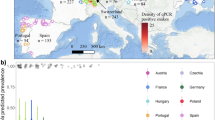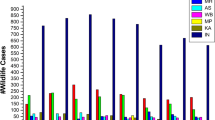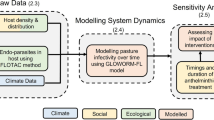Abstract
Bats are important wildlife to their ecologic system, but they are also a zoonotic disease reservoir. Close bat–human interaction can lead to pathogen spillover. We conducted a qualitative study in two districts of Bangladesh and interviewed 30 bat hunters who hunt bats primarily for consumption, to understand the process and their reasons for hunting bats and their perceptions about bats and bat-borne disease. Most hunters catch bats during winter nights, using a net. Bat meat is used for household consumption, and the surplus is sold to cover household expenditures. They prepare the bat meat at home to sell it in their own and in neighboring communities. They also sell live bats to traditional healers. They report that the bat population has declined compared with 5 or 10 years ago, a decline they attribute to hunting and deforestation. Many have heard of a disease from bat-contaminated date palm sap but do not believe that bats can spread such disease to humans. Close bat–human interaction reported in this study pose a risk of pathogen spillover. Conservation initiatives have the potential to reduce such interaction and so both reduce disease risk and support the ecology.
Similar content being viewed by others
References
Ahammad, R., M. K. Hossain, and P. Husnain. 2014. Governance of forest conservation and co-benefits for Bangladesh under changing climate. Journal of Forestry Research 25:29-36.
Barrett, R., and P. J. Brown. 2008. Stigma in the time of influenza: social and institutional responses to pandemic emergencies. J Infect Dis 197 Suppl 1:S34-S37.
Brashares, J. S., C. D. Golden, K. Z. Weinbaum, C. B. Barrett, and G. V. Okello. 2011. Economic and geographic drivers of wildlife consumption in rural Africa. Proc Natl Acad Sci U S A 108:13931-13936.
Calisher, C. H., J. E. Childs, H. E. Field, K. V. Holmes, and T. Schountz. 2006. Bats: important reservoir hosts of emerging viruses. Clin Microbiol Rev 19:531-545.
Chowdhury, M. S. H., C. Gudmundsson, S. Izumiyama, M. Koike, N. Nazia, M. P. Rana, S. A. Mukul, N. Muhammed, and M. Redowan. 2014. Community attitudes toward forest conservation programs through collaborative protected area management in Bangladesh. Environment, Development and Sustainability 16:1235-1252.
Chowdhury, M. S. H., M. Koike, and N. Muhammed. 2009. Embracing Collaborative Protected Area Management for Conservation: An Analysis of the Development of the Forest Policy of Bangladesh. International Forestry Review 11:359-374.
Coltart, C. E., B. Lindsey, I. Ghinai, A. M. Johnson, and D. L. Heymann. 2017. The Ebola outbreak, 2013-2016: old lessons for new epidemics. Philos Trans R Soc Lond B Biol Sci 372:20160297.
Eaton, B. T., C. C. Broder, D. Middleton, and L. F. Wang. 2006. Hendra and Nipah viruses: different and dangerous. Nat Rev Microbiol 4:23-35.
Gustafsson, M., J. Ekholm, and A. Ohman. 2004. From shame to respect: musculoskeletal pain patients’ experience of a rehabilitation programme, a qualitative study. Journal of Rehabilitation Medicine 36:97-103.
Halpin, K., A. D. Hyatt, R. Fogarty, D. Middleton, J. Bingham, J. H. Epstein, S. A. Rahman, T. Hughes, C. Smith, H. E. Field, P. Daszak, Henipavirus Ecology Research Group. 2011. Pteropid bats are confirmed as the reservoir hosts of henipaviruses: a comprehensive experimental study of virus transmission. Am J Trop Med Hyg 85:946-951.
Jones, E., S. R. Lattof, and E. Coast. 2017. Interventions to provide culturally-appropriate maternity care services: factors affecting implementation. BMC Pregnancy Childbirth 17:267.
Kamins, A. O., O. Restif, Y. Ntiamoa-Baidu, R. Suu-Ire, D. T. Hayman, A. A. Cunningham, J. L. Wood, and J. M. Rowcliffe. 2011. Uncovering the fruit bat bushmeat commodity chain and the true extent of fruit bat hunting in Ghana, West Africa. Biol Conserv 144:3000-3008.
Khan, M. A. R. 2001. Staus and distribution of bats in Bangladesh with notes on their ecology. Zoos’ Print Journal 16:479-483.
Kunz, T. H., E. Braun de Torrez, D. Bauer, T. Lobova, and T. H. Fleming. 2011. Ecosystem services provided by bats. Ann N Y Acad Sci 1223:1-38.
Lane, D. J. W., T. Kingston, and B. Lee. 2006. Dramatic decline in bat species richness in Singapore, with implication for Southeast Asia. Biological Conservation 131:584-593.
Leach, M., and M. Tadros. 2014. Epidemics and the politics of knowledge: contested narratives in Egypt’s H1N1 response. Med Anthropol 33:240-254.
Luby, S. P. 2013. The pandemic potential of Nipah virus. Antiviral Res 100:38-43.
Lyons, T., K. Shannon, L. Pierre, W. Small, A. Krusi, and T. Kerr. 2015. A qualitative study of transgender individuals’ experiences in residential addiction treatment settings: stigma and inclusivity. Substance Abuse Treatment, Prevention and Policy 10:17.
Mickleburgh, S., K. Waylen, and P. Racey. 2009. Bats as bushmeat: a global review. Oryx 43:217-234.
Mickleburgh, S. P., A. M. Huston, and P. A. Racey. 2002. A review of the global conservation status of bats Oryx 36:18.
Mildenstein, T., I. Tanshi, and P. A. Racey. 2016. Exploitation of Bats for Bushmeat and Medicine. Pages 325-376 in C. C. Voigt and T. Kingston, editors. Bats in the Anthropocene: Conservation of Bats in a Changing World. SpringerOpen.
Muscarella, R., and T. H. Fleming. 2007. The role of frugivorous bats in tropical forest succession. Biol Rev Camb Philos Soc 82:573-590.
Nahar, N., R. C. Paul, R. Sultana, S. A. Sumon, K. C. Banik, J. Abedin, M. Asaduzzaman, F. Garcia, S. Zimicki, M. Rahman, E. S. Gurley, and S. P. Luby. 2017. A Controlled Trial to Reduce the Risk of Human Nipah Virus Exposure in Bangladesh. Ecohealth 14:501-517.
Nahar, N., M. Uddin, R. A. Sarkar, E. S. Gurley, M. S. Uddin Khan, M. J. Hossain, R. Sultana, and S. P. Luby. 2013. Exploring pig raising in Bangladesh: implications for public health interventions. Vet Ital 49:7-17.
Openshaw, J. J., S. Hegde, H. M. S. Sazzad, S. U. Khan, M. J. Hossain, J. H. Epstein, P. Daszak, E. S. Gurley, and S. P. Luby. 2017. Bat Hunting and Bat–Human Interactions in Bangladeshi Villages: Implications for Zoonotic Disease Transmission and Bat Conservation. Transbound Emerg Dis 64:1287-1293.
Padmawati, S., and M. Nichter. 2008. Community response to avian flu in Central Java, Indonesia. Anthropol Med 15:31-51.
Plowright, R. K., P. Eby, P. J. Hudson, I. L. Smith, D. Westcott, W. L. Bryden, D. Middleton, P. A. Reid, R. A. McFarlane, G. Martin, G. M. Tabor, L. F. Skerratt, D. L. Anderson, G. Crameri, D. Quammen, D. Jordan, P. Freeman, L. F. Wang, J. H. Epstein, G. A. Marsh, N. Y. Kung, and H. McCallum. 2015. Ecological dynamics of emerging bat virus spillover. Proc Biol Sci 282:20142124.
Reddy, C. S., S. V. Pasha, C. S. Jha, P. G. Diwakar, and V. K. Dadhwal. 2016. Development of national database on long-term deforestation (1930–2014) in Bangladesh. Global and Planetary Change 139:173-182.
Salam, M. A., and T. Noguchi. 1998. Factors Influencing the Loss of Forest Cover in Bangladesh: An Analysis from Socioeconomic and Demographic Perspectives. Journal of Forest Research 3:145-150.
Schneeberger, K., and C. C. Voigt. 2016. Zoonotic Viruses and Conservation of Bats. Pages 263-292 in C. C. Voigt and T. Kingston, editors. Bats in the Anthropocene: Conservation of Bats in a Changing World. Springer International Publishing, Cham.
Smith, I., and L.-F. Wang. 2013. Bats and their virome: an important source of emerging viruses capable of infecting humans. Current Opinion in Virology 3:84-91.
Struebig, M. J., M. E. Herrison, S. M. Cheyne, and S. H. Limin. 2007. Intensive hunting of large flying foxes Pteropus vampyrus natunae in Central Kalimantan, Indonesian Borneo. Oryx 41:390-393.
Suwannarong, K., and S. Schuler. 2016. Bat consumption in Thailand. Infect Ecol Epidemiol 6:29941.
The World Bank (2018) The World Bank Data. Forest area (% of land area), 1990-2015. Retrieved from https://data.worldbank.org/indicator/AG.LND.FRST.ZS?locations=BD 16 October 2018.
Wolfe, N. D., P. Daszak, A. M. Kilpatrick, and D. S. Burke. 2005. Bushmeat hunting, deforestation, and prediction of zoonoses emergence. Emerg Infect Dis 11:1822-1827.
Wong, S., S. Lau, P. Woo, and K. Y. Yuen. 2007. Bats as a continuing source of emerging infections in humans. Rev Med Virol 17:67-91.
Yob, J. M., H. Field, A. M. Rashdi, C. Morrissy, B. van der Heide, P. Rota, A. bin Adzhar, J. White, P. Daniels, A. Jamaluddin, and T. Ksiazek. 2001. Nipah virus infection in bats (order Chiroptera) in Peninsular Malaysia. Emerg Infect Dis 7:439-441.
Acknowledgements
Support for this study was provided by FHI 360 with funds from USAID Cooperative Agreement GHN-A-00-09-00002-00; this study was made possible by the generous support of the American people through the United States Agency for International Development (USAID). icddr,b acknowledges with gratitude the commitment of FHI 360 to the Centre’s research efforts. icddr,b is thankful to the Governments of Bangladesh, Canada, Sweden and the UK for providing core/unrestricted support. We are grateful to all the study participants for their valuable time. We acknowledge the continuous support of Professor Marcel Tanner from Swiss Tropical and Public Health Institute.
Author information
Authors and Affiliations
Corresponding author
Ethics declarations
Conflict of interest
The authors declare that they have no conflict of interest.
Human and Animal Rights
All procedures performed in studies involving human participants were in accordance with the ethical standards of the institutional and/or national research committee and with the 1964 Helsinki Declaration and its later amendments or comparable ethical standards. The interviewers obtained written informed consent prior to conducting the interviews. The team did not record information that can identify the particular informant and labeled each interview with a number. Human subject review committees at icddr,b and FHI 360 approved the study protocol.
Electronic Supplementary Material
Below is the link to the electronic supplementary material.
Rights and permissions
About this article
Cite this article
Nahar, N., Asaduzzaman, M., Mandal, U.K. et al. Hunting Bats for Human Consumption in Bangladesh. EcoHealth 17, 139–151 (2020). https://doi.org/10.1007/s10393-020-01468-x
Received:
Revised:
Accepted:
Published:
Issue Date:
DOI: https://doi.org/10.1007/s10393-020-01468-x




